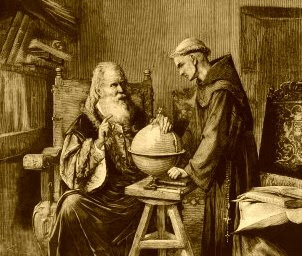Philosophy

This is somewhat unusual...that earlier observations of double stars negated the conclusions written in Galileo Galilei's Dialogue Concerning the Two Chief World Systems [1632]...such is the hypothesis in Christopher M. Graney's "Regarding the Potential Impact of Double Star Observations on Conceptions of the Universe of Stars in the Early 17th Century".
ABSTRACT:
Galileo Galilei believed that stars were distant suns whose sizes measured via his telescope were a direct indication of distance -- fainter stars (appearing smaller in the telescope) being farther away than brighter ones. Galileo argued in his Dialogue that telescopic observation of a chance alignment of a faint (distant) and bright (closer) star would reveal annual parallax, if such double stars were found. This would provide support both for Galileo's ideas concerning the nature of stars and for the motion of the Earth. However, Galileo actually made observations of such double stars, well before publication of the Dialogue. We show that the results of these observations, and the likely results of observations of any double star that was a viable subject for Galileo's telescope, would undermine Galileo's ideas, not support them. We argue that such observations would lead either to the more correct idea that stars were sun-like bodies of varying sizes which could be physically grouped, or to the less correct idea that stars are not sun-like bodies, and even to the idea that the Earth did not move.
REGARDING THE POTENTIAL IMPACT OF DOUBLE STAR OBSERVATIONS ON CONCEPTIONS OF THE UNIVERSE OF STARS IN THE EARLY 17TH CENTURY
Signores Salviati, Sagrfdo, and Simplicio--cosmology debate by Galileo
- Galileo's Battle For The Heavens
400 years ago today, Galileo Galilei introduced his first telescope to the world. The discoveries Galileo would make with this rather simple instrument, as well as the application of mathematical descriptions of his observations, would revolutionize our...
- Franceso Ingoli, Galileo And The Roman Inquisition
In January of 1616, the month before before the Roman Inquisition would infamously condemn the Copernican theory as being “foolish and absurd in philosophy”, Monsignor Francesco Ingoli addressed Galileo Galilei with an essay entitled “Disputation...
- Galileo's "the Starry Messinger"
A 400 year old document is still interesting to read. Steven Kreis wrote... About ten months ago a report reached my ears that a certain Fleming had constructed a spyglass by means of which visible objects, though very distant from the eye of the observer,...
- Galileo's Discovery Of Neptune
Wikipedia: Galileo's drawings show that he first observed Neptune on December 28, 1612, and again on January 27, 1613. On both occasions, Galileo mistook Neptune for a fixed star when it appeared very close—in conjunction—to Jupiter in the night...
- Galileo Galilei...revolutionary
Galileo Galilei 1564-1642 Bye, bye Ptolemy...the great Galileo Galilei. The Galileo Project...
Philosophy
Double star observations--Galileo Galilei

Galileo Galilei Demonstrates His Astronomical Theories to a Monk
This is somewhat unusual...that earlier observations of double stars negated the conclusions written in Galileo Galilei's Dialogue Concerning the Two Chief World Systems [1632]...such is the hypothesis in Christopher M. Graney's "Regarding the Potential Impact of Double Star Observations on Conceptions of the Universe of Stars in the Early 17th Century".
ABSTRACT:
Galileo Galilei believed that stars were distant suns whose sizes measured via his telescope were a direct indication of distance -- fainter stars (appearing smaller in the telescope) being farther away than brighter ones. Galileo argued in his Dialogue that telescopic observation of a chance alignment of a faint (distant) and bright (closer) star would reveal annual parallax, if such double stars were found. This would provide support both for Galileo's ideas concerning the nature of stars and for the motion of the Earth. However, Galileo actually made observations of such double stars, well before publication of the Dialogue. We show that the results of these observations, and the likely results of observations of any double star that was a viable subject for Galileo's telescope, would undermine Galileo's ideas, not support them. We argue that such observations would lead either to the more correct idea that stars were sun-like bodies of varying sizes which could be physically grouped, or to the less correct idea that stars are not sun-like bodies, and even to the idea that the Earth did not move.
REGARDING THE POTENTIAL IMPACT OF DOUBLE STAR OBSERVATIONS ON CONCEPTIONS OF THE UNIVERSE OF STARS IN THE EARLY 17TH CENTURY
Signores Salviati, Sagrfdo, and Simplicio--cosmology debate by Galileo
- Galileo's Battle For The Heavens
400 years ago today, Galileo Galilei introduced his first telescope to the world. The discoveries Galileo would make with this rather simple instrument, as well as the application of mathematical descriptions of his observations, would revolutionize our...
- Franceso Ingoli, Galileo And The Roman Inquisition
In January of 1616, the month before before the Roman Inquisition would infamously condemn the Copernican theory as being “foolish and absurd in philosophy”, Monsignor Francesco Ingoli addressed Galileo Galilei with an essay entitled “Disputation...
- Galileo's "the Starry Messinger"
A 400 year old document is still interesting to read. Steven Kreis wrote... About ten months ago a report reached my ears that a certain Fleming had constructed a spyglass by means of which visible objects, though very distant from the eye of the observer,...
- Galileo's Discovery Of Neptune
Wikipedia: Galileo's drawings show that he first observed Neptune on December 28, 1612, and again on January 27, 1613. On both occasions, Galileo mistook Neptune for a fixed star when it appeared very close—in conjunction—to Jupiter in the night...
- Galileo Galilei...revolutionary
Galileo Galilei 1564-1642 Bye, bye Ptolemy...the great Galileo Galilei. The Galileo Project...
